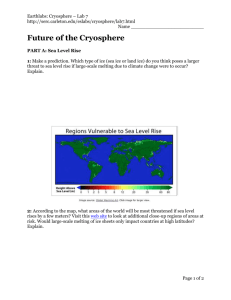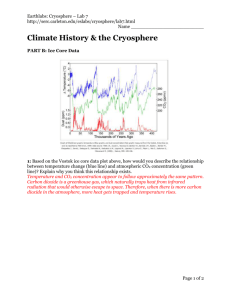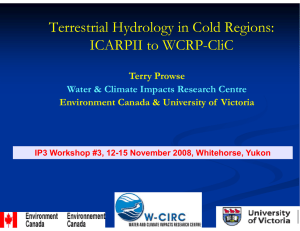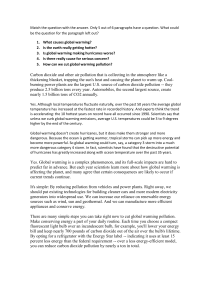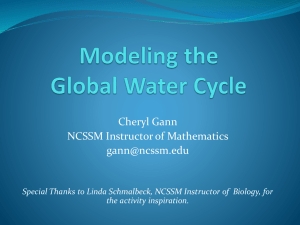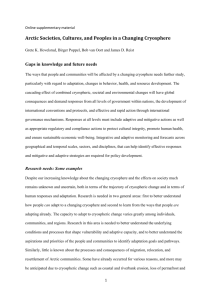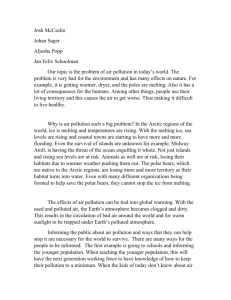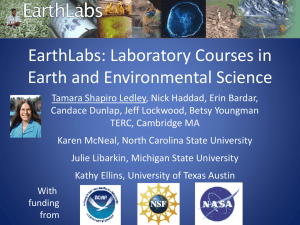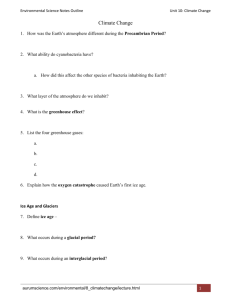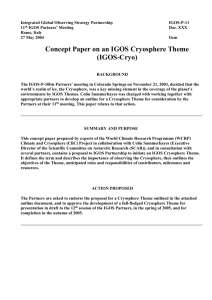ICCI News Release here - International Cryosphere Climate Initiative
advertisement
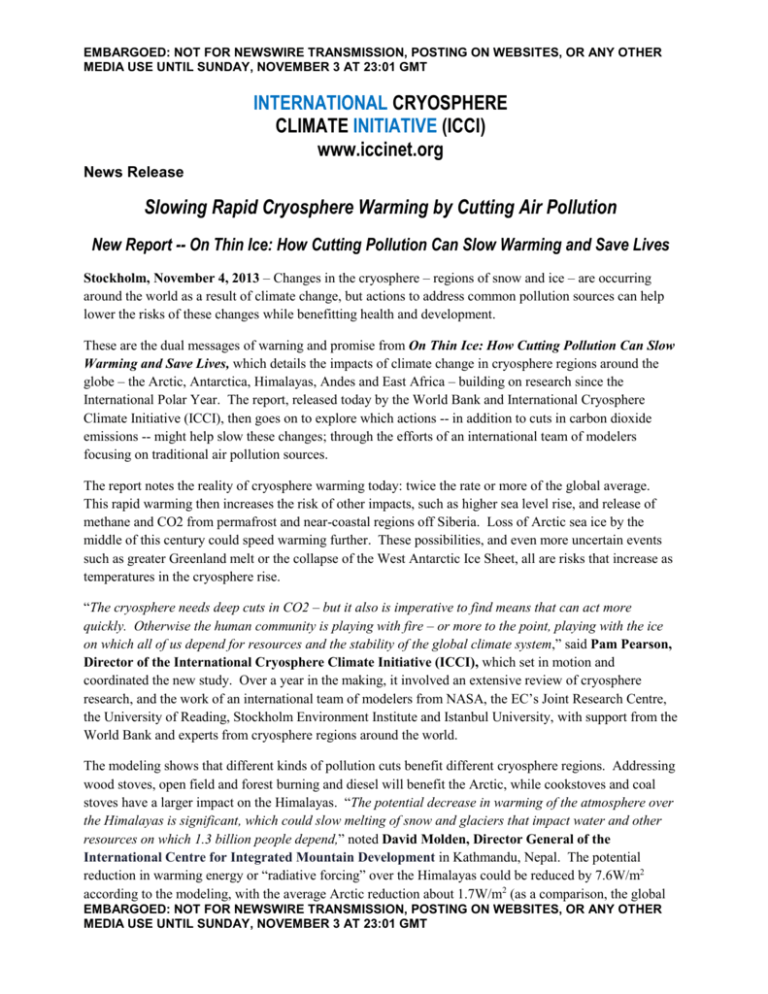
EMBARGOED: NOT FOR NEWSWIRE TRANSMISSION, POSTING ON WEBSITES, OR ANY OTHER MEDIA USE UNTIL SUNDAY, NOVEMBER 3 AT 23:01 GMT INTERNATIONAL CRYOSPHERE CLIMATE INITIATIVE (ICCI) www.iccinet.org News Release Slowing Rapid Cryosphere Warming by Cutting Air Pollution New Report -- On Thin Ice: How Cutting Pollution Can Slow Warming and Save Lives Stockholm, November 4, 2013 – Changes in the cryosphere – regions of snow and ice – are occurring around the world as a result of climate change, but actions to address common pollution sources can help lower the risks of these changes while benefitting health and development. These are the dual messages of warning and promise from On Thin Ice: How Cutting Pollution Can Slow Warming and Save Lives, which details the impacts of climate change in cryosphere regions around the globe – the Arctic, Antarctica, Himalayas, Andes and East Africa – building on research since the International Polar Year. The report, released today by the World Bank and International Cryosphere Climate Initiative (ICCI), then goes on to explore which actions -- in addition to cuts in carbon dioxide emissions -- might help slow these changes; through the efforts of an international team of modelers focusing on traditional air pollution sources. The report notes the reality of cryosphere warming today: twice the rate or more of the global average. This rapid warming then increases the risk of other impacts, such as higher sea level rise, and release of methane and CO2 from permafrost and near-coastal regions off Siberia. Loss of Arctic sea ice by the middle of this century could speed warming further. These possibilities, and even more uncertain events such as greater Greenland melt or the collapse of the West Antarctic Ice Sheet, all are risks that increase as temperatures in the cryosphere rise. “The cryosphere needs deep cuts in CO2 – but it also is imperative to find means that can act more quickly. Otherwise the human community is playing with fire – or more to the point, playing with the ice on which all of us depend for resources and the stability of the global climate system,” said Pam Pearson, Director of the International Cryosphere Climate Initiative (ICCI), which set in motion and coordinated the new study. Over a year in the making, it involved an extensive review of cryosphere research, and the work of an international team of modelers from NASA, the EC’s Joint Research Centre, the University of Reading, Stockholm Environment Institute and Istanbul University, with support from the World Bank and experts from cryosphere regions around the world. The modeling shows that different kinds of pollution cuts benefit different cryosphere regions. Addressing wood stoves, open field and forest burning and diesel will benefit the Arctic, while cookstoves and coal stoves have a larger impact on the Himalayas. “The potential decrease in warming of the atmosphere over the Himalayas is significant, which could slow melting of snow and glaciers that impact water and other resources on which 1.3 billion people depend,” noted David Molden, Director General of the International Centre for Integrated Mountain Development in Kathmandu, Nepal. The potential reduction in warming energy or “radiative forcing” over the Himalayas could be reduced by 7.6W/m2 according to the modeling, with the average Arctic reduction about 1.7W/m2 (as a comparison, the global EMBARGOED: NOT FOR NEWSWIRE TRANSMISSION, POSTING ON WEBSITES, OR ANY OTHER MEDIA USE UNTIL SUNDAY, NOVEMBER 3 AT 23:01 GMT EMBARGOED: NOT FOR NEWSWIRE TRANSMISSION, POSTING ON WEBSITES, OR ANY OTHER MEDIA USE UNTIL SUNDAY, NOVEMBER 3 AT 23:01 GMT mean average is about 2.3W/m2 in the atmosphere today). Reductions from diesel and cookstove pollution sources might even benefit Antarctica, especially the sensitive Antarctic Peninsula. Health benefits proved just as compelling. According to the report, use of advanced cook-stoves – such as those that are fan-assisted or use biogas – could prevent one million deaths annually from outdoor air pollution alone; and with the improvement of air quality inside the home, benefits would be greater still. “This report underscores the need to address clean cookstoves and fuels as a solution to a growing public health crisis,” said Radha Muthiah, Executive Director of the Global Alliance for Clean Cookstoves. “The gender, economic and climate benefits of clean cooking solutions must compel us to greater action.” The Global Burdens of Disease estimates that every year, 4 million people die from exposure to household smoke from coosktoves. Measures to address other pollution sources also provided strong health benefits in the modeling. Just a 50-percent drop in open field and forest burning could result in 190,000 fewer deaths globally every year. Use of improved wood and coal stoves for heating could save 230,000 lives annually, many of these in OECD nations as well as East Asia. The modeling built on an earlier Assessment by the United Nations Environment Programme and World Meteorological Organization. “This report is an important contribution to the World Bank's work on development and climate,” said Rachel Kyte, Vice President for Sustainable Development at the World Bank, which along with the Flora Family Foundation supported the study. “It clearly identifies the risks that black carbon and methane pose to the poorest and most vulnerable, as well as the climate benefits of early, scalable action irrespective of global agreements. Critically, it also provides solutions for clean growth, and opportunities to help meet World Bank Group goals of ending extreme poverty by 2030 and boosting shared prosperity.” Cuts in pollution from sources that produce methane such as oil and gas, and coal production bring crop as well as climate benefits. Together with diesel sources (which also impacts the ground-level ozone harmful to crops), methane measure reductions could result in more than 30 million tons of additional yield in crops such as rice, soy and wheat, especially in Southeast Asia and North America; and also avert 340,000 premature deaths. Methane reductions also benefited the Arctic, and could result in slowing the rise in temperature there by a full degree in some Arctic regions. Combined with black carbon reductions, it could lead to less loss of sea ice and snow cover: up to 40% reduced loss of sea ice and 25% reduced loss of snow cover by midcentury. Much of these methane emissions come from front-end activities of fossil fuel exploitation. “Our hope is that this study will raise the profile of the cryosphere as well as the urgency needed to address climate change there, using both the tool of CO2 reductions, and these improvements in air quality,” concluded Pearson. “It truly is a dual cryosphere and development imperative for action.” Contacts: ICCI-Europe: Svante Bodin, +46-722-350878, svante@iccinet.org ICCI-Global: Pam Pearson, +1-802-488-0991, pam@iccinet.org GACC: Sean Bartlett, +1-202-419-6401, sbartlett@cleancookstoves.org ICIMOD: David Molden, +977-1-5003222, dmolden@icimod.org World Bank: Robert Bisset, +1-202-458-5191, Cell: (202) 415-9646, rbisset@worldbank.org EMBARGOED: NOT FOR NEWSWIRE TRANSMISSION, POSTING ON WEBSITES, OR ANY OTHER MEDIA USE UNTIL SUNDAY, NOVEMBER 3 AT 23:01 GMT
